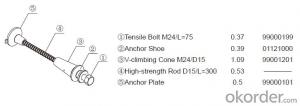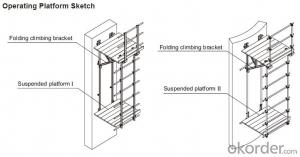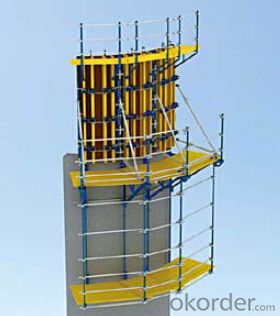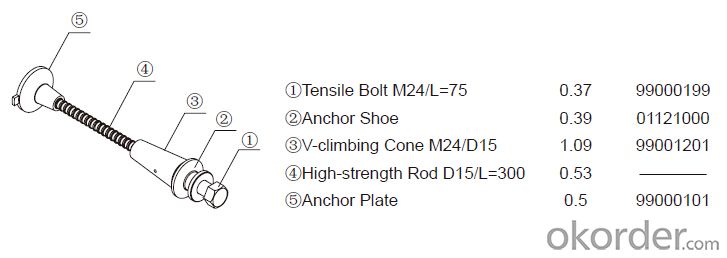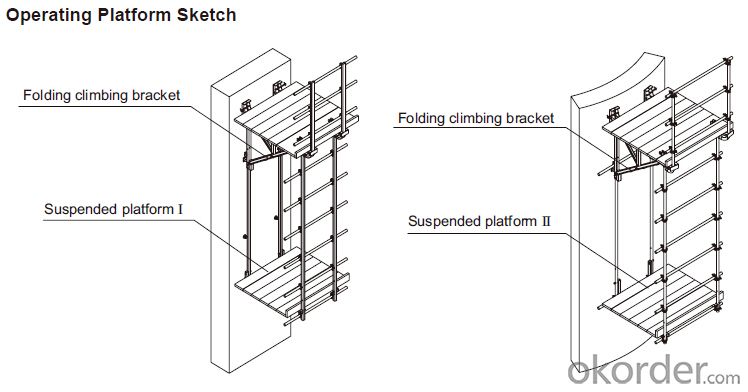Climbing-platform CP190 for formwork and scaffolding system
- Loading Port:
- Tianjin
- Payment Terms:
- TT OR LC
- Min Order Qty:
- 50 m²
- Supply Capability:
- 1000 m²/month
OKorder Service Pledge
OKorder Financial Service
You Might Also Like
Climbing Platform CP190
Climbing bracket CP190 is mainly used as operating platform during construction. It can be used
on the vertical wall and arced wall. The bracket hang on the anchor system and all the load are
supported by anchor system. It’s convenient to assemble and dismantle, the construction is easy,
rapid and safe.
Anchor System:
Anchor system is the most important supporting part. The system is made of five parts shown
below. There into, tensile bolt, anchor shoe and V-climbing cone can be taken out for reusing.
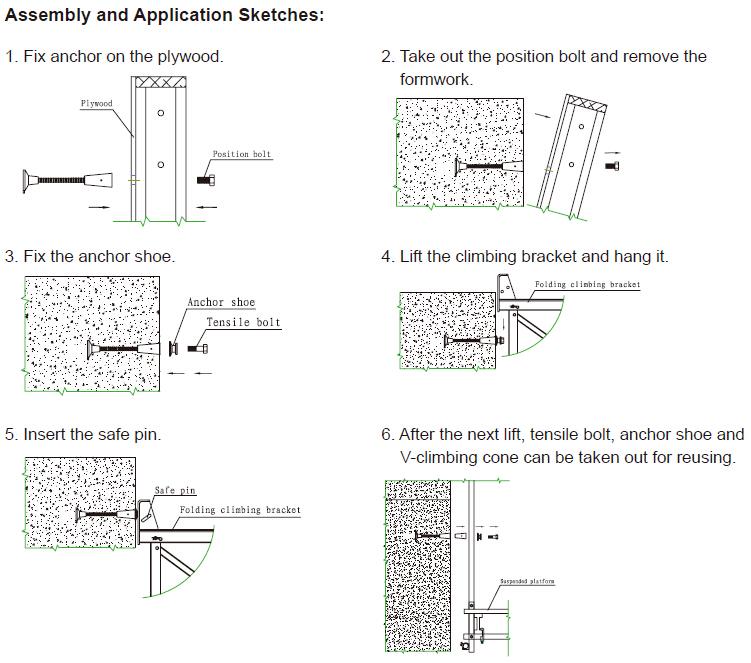
- Q: How does steel formwork affect the overall sound insulation of a building?
- Steel formwork does not directly affect the overall sound insulation of a building. Sound insulation primarily depends on the quality and design of the walls, floors, and ceilings, which are independent of the formwork material. However, steel formwork may indirectly impact sound insulation during the construction phase. Steel formwork is known for its rigidity and strength, which helps in ensuring accurate and precise concrete pouring. This precise construction technique can minimize the gaps and imperfections that may occur during the casting of concrete. As a result, steel formwork can contribute to creating a smoother and more uniform concrete surface, reducing the chances of sound leakage through cracks or joints. Furthermore, steel formwork can be used to create smooth and even surfaces, which can facilitate the installation of soundproofing materials such as acoustic panels or insulation. These additional soundproofing measures, when incorporated during the construction phase, can enhance the overall sound insulation of the building. It's important to note that while steel formwork can indirectly influence sound insulation during construction, the primary factors affecting sound insulation are the materials and techniques used for constructing walls, floors, and ceilings. Architectural design, insulation materials, and sealing techniques play a crucial role in achieving optimal sound insulation levels.
- Q: What types of concrete structures can be built using steel formwork?
- Steel formwork is versatile and can be used to construct a wide range of concrete structures. Some common examples include walls, columns, beams, slabs, foundations, and even complex structures like bridges and tunnels. The strength and durability of steel formwork make it suitable for projects of varying scales and complexities, offering a sturdy and efficient solution for creating high-quality concrete structures.
- Q: How does steel formwork handle concrete flowability and workability?
- Steel formwork is highly effective in handling concrete flowability and workability. Its smooth and rigid surface allows for easy movement and placement of concrete, ensuring a consistent and uniform flow during the pouring process. Additionally, steel formwork provides excellent support and stability, preventing any deformation or leakage of concrete. Its strength and durability enable it to withstand the pressure exerted by the concrete, ensuring that the formwork retains its shape and integrity throughout the entire curing period. Overall, steel formwork plays a crucial role in maintaining the desired flowability and workability of concrete, resulting in high-quality and structurally sound constructions.
- Q: How does steel formwork affect the overall construction schedule and sequencing?
- Steel formwork can significantly impact the overall construction schedule and sequencing in a positive way. Compared to traditional formwork materials, steel formwork offers faster installation and dismantling times, which can save a considerable amount of time during construction. Its reusable nature also allows for faster cycle times, leading to improved productivity and faster completion of concrete pouring and curing processes. Additionally, steel formwork provides better quality control and accuracy in terms of dimensions and alignment, resulting in reduced rework and potential delays. Overall, the use of steel formwork can help expedite construction timelines and improve project sequencing.
- Q: How does steel formwork affect the overall construction waste generation?
- Steel formwork can significantly reduce overall construction waste generation. Unlike traditional timber formwork, steel formwork is reusable, durable, and can be used for multiple construction projects. This means that less formwork material needs to be discarded and replaced after each use, reducing the amount of waste generated. Additionally, steel formwork is easier to clean and maintain, further reducing wastage. Overall, the use of steel formwork in construction projects helps minimize waste generation and promotes sustainable construction practices.
- Q: How does steel formwork affect the overall accuracy of concrete structures?
- Steel formwork can significantly impact the overall accuracy of concrete structures in a positive manner. The use of steel formwork ensures precise alignment and dimensional accuracy, resulting in a more accurate and uniform structure. Steel formwork provides a rigid and stable framework, which helps to maintain the desired shape and dimensions of the concrete during the pouring and curing process. This stability minimizes any potential deformation or distortion, ensuring that the final structure is true to its design specifications. Furthermore, steel formwork allows for a smoother surface finish of the concrete. The smoothness of the formwork surface reduces the chances of any imperfections or irregularities in the final structure, enhancing its aesthetics and overall quality. The use of steel formwork also allows for greater control and precision in the placement and positioning of reinforcement bars, which are critical for the structural integrity of the concrete. The accurate placement of reinforcement bars ensures that they are properly embedded within the concrete, leading to a stronger and more durable structure. In addition, steel formwork provides a high level of reusability, which further contributes to accuracy. Its durability allows for multiple uses, reducing the chances of wear and tear that could affect the formwork's alignment and accuracy. Overall, the use of steel formwork in concrete construction plays a crucial role in ensuring the overall accuracy of the structure. It provides stability, precise alignment, and smooth formwork surfaces, resulting in a more accurate and aesthetically pleasing concrete structure.
- Q: What are the common safety certifications for steel formwork?
- Construction projects utilize various safety certifications to ensure the compliance of steel formwork with specific safety regulations and standards. The OSHA certification, widely recognized for its Occupational Safety and Health Administration, guarantees that the steel formwork adheres to OSHA's safety regulations. This certification encompasses elements like stability, load-bearing capacity, and structural integrity. Another reputable certification is provided by the American National Standards Institute (ANSI), which establishes standards for construction equipment and materials, including steel formwork. This certification assures that the formwork meets essential safety requirements, such as strength, durability, and stability. In Europe, the EN 12812 standard is crucial for certifying steel formwork. It outlines the requirements for formwork systems and confirms their safety and performance. The certification assesses aspects like load-bearing capacity, stability, and safety factors. Additionally, the International Organization for Standardization (ISO) offers certifications related to steel formwork safety. The ISO 9001 certification ensures that the manufacturer possesses a quality management system, while the ISO 45001 certification focuses on occupational health and safety management systems. Depending on the country or region, additional specific certifications may be necessary. For instance, the British Standards Institution (BSI) certification may be required in the United Kingdom. Overall, these safety certifications for steel formwork provide construction professionals with confidence that the formwork they employ meets the requisite safety standards and regulations. It is crucial to ensure that certified steel formwork is utilized on construction sites to prevent accidents, prioritize worker safety, and maintain the structural integrity of the formwork.
- Q: Can steel formwork withstand extreme weather conditions?
- Yes, steel formwork is designed to withstand extreme weather conditions. Steel is known for its strength and durability, making it highly resistant to harsh weather elements such as heavy rain, strong winds, and high temperatures. Additionally, steel formwork is often treated with protective coatings to further enhance its resistance to corrosion and degradation caused by extreme weather conditions.
- Q: Can steel formwork be used for both indoor and outdoor construction projects?
- Steel formwork is suitable for both indoor and outdoor construction projects, providing durability and strength. It can withstand different weather conditions, making it an ideal choice for outdoor projects. This material is highly robust and can support the weight of concrete and other construction materials, ensuring stability. Another advantage of steel formwork is its reusability, making it a cost-effective option for both indoor and outdoor projects. Construction professionals widely prefer its versatility and resilience for various applications.
- Q: Can steel formwork be used for staircases and ramps?
- Yes, steel formwork can be used for staircases and ramps. Steel formwork provides high strength, durability, and flexibility, making it suitable for constructing various types of structures, including staircases and ramps. Its ability to handle heavy loads and resist wear and tear makes it a popular choice in the construction industry for such applications.
Send your message to us
Climbing-platform CP190 for formwork and scaffolding system
- Loading Port:
- Tianjin
- Payment Terms:
- TT OR LC
- Min Order Qty:
- 50 m²
- Supply Capability:
- 1000 m²/month
OKorder Service Pledge
OKorder Financial Service
Similar products
Hot products
Hot Searches
Related keywords

